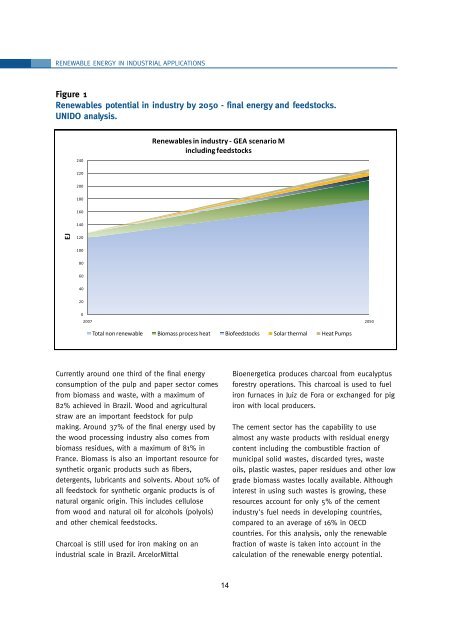Renewable Energy in Industrial Applications â an ... - Unido
Renewable Energy in Industrial Applications â an ... - Unido
Renewable Energy in Industrial Applications â an ... - Unido
Create successful ePaper yourself
Turn your PDF publications into a flip-book with our unique Google optimized e-Paper software.
RENEWABLE ENERGY IN INDUSTRIAL APPLICATIONS<br />
Figure 1<br />
<strong>Renewable</strong>s potential <strong>in</strong> <strong>in</strong>dustry by 2050 - f<strong>in</strong>al energy <strong>an</strong>d feedstocks.<br />
UNIDO <strong>an</strong>alysis.<br />
240<br />
<strong>Renewable</strong>s <strong>in</strong> <strong>in</strong>dustry - GEA scenario M<br />
<strong>in</strong>clud<strong>in</strong>g feedstocks<br />
220<br />
200<br />
180<br />
160<br />
140<br />
EJ<br />
120<br />
100<br />
80<br />
60<br />
40<br />
20<br />
0<br />
2007 2050<br />
Total non renewable Biomass process heat Biofeedstocks Solar thermal Heat Pumps<br />
Currently around one third of the f<strong>in</strong>al energy<br />
consumption of the pulp <strong>an</strong>d paper sector comes<br />
from biomass <strong>an</strong>d waste, with a maximum of<br />
82% achieved <strong>in</strong> Brazil. Wood <strong>an</strong>d agricultural<br />
straw are <strong>an</strong> import<strong>an</strong>t feedstock for pulp<br />
mak<strong>in</strong>g. Around 37% of the f<strong>in</strong>al energy used by<br />
the wood process<strong>in</strong>g <strong>in</strong>dustry also comes from<br />
biomass residues, with a maximum of 81% <strong>in</strong><br />
Fr<strong>an</strong>ce. Biomass is also <strong>an</strong> import<strong>an</strong>t resource for<br />
synthetic org<strong>an</strong>ic products such as fibers,<br />
detergents, lubric<strong>an</strong>ts <strong>an</strong>d solvents. About 10% of<br />
all feedstock for synthetic org<strong>an</strong>ic products is of<br />
natural org<strong>an</strong>ic orig<strong>in</strong>. This <strong>in</strong>cludes cellulose<br />
from wood <strong>an</strong>d natural oil for alcohols (polyols)<br />
<strong>an</strong>d other chemical feedstocks.<br />
Charcoal is still used for iron mak<strong>in</strong>g on <strong>an</strong><br />
<strong>in</strong>dustrial scale <strong>in</strong> Brazil. ArcelorMittal<br />
Bioenergetica produces charcoal from eucalyptus<br />
forestry operations. This charcoal is used to fuel<br />
iron furnaces <strong>in</strong> Juiz de Fora or exch<strong>an</strong>ged for pig<br />
iron with local producers.<br />
The cement sector has the capability to use<br />
almost <strong>an</strong>y waste products with residual energy<br />
content <strong>in</strong>clud<strong>in</strong>g the combustible fraction of<br />
municipal solid wastes, discarded tyres, waste<br />
oils, plastic wastes, paper residues <strong>an</strong>d other low<br />
grade biomass wastes locally available. Although<br />
<strong>in</strong>terest <strong>in</strong> us<strong>in</strong>g such wastes is grow<strong>in</strong>g, these<br />
resources account for only 5% of the cement<br />
<strong>in</strong>dustry's fuel needs <strong>in</strong> develop<strong>in</strong>g countries,<br />
compared to <strong>an</strong> average of 16% <strong>in</strong> OECD<br />
countries. For this <strong>an</strong>alysis, only the renewable<br />
fraction of waste is taken <strong>in</strong>to account <strong>in</strong> the<br />
calculation of the renewable energy potential.<br />
14

















